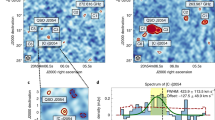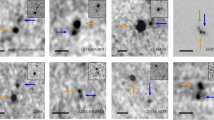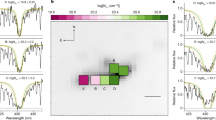Abstract
LYMAN-α 1,216 Å photons may be produced in a variet of astrophysical situations. These photons are lost thrugh two-photon emission on interacting with hydrogen gas, ind through absorption by interstellar grains, but velocity diferences between the regions of production and destructior of these photons renders their destruction by the two-phcon emission process relatively inefficient1. Grain absorption is therefore the primary loss mechanism, but since it occurs cer path lengths ≳ 50 pc, there are significant interstellar Ly-α fluxes. An early theoretical estimate1 of the interstellar flux of diffuse Ly-α photons yielded a value ∼ 6.4×10−4 erg cm−2 s−1 sr−1. This estimate agrees well with the first Marine-5 and Mariner-6 observations of this flux by Barth2,3, the later giving a value of ∼ 4.9 × 10−4 erg cm−2s −1sr−1. Later author4,5 have queried the precise fraction of this observed radiation which is genuinely extra-solar, although a significant interstehr component of Ly-α flux is generally conceded. A value in tie range 1−4×10−4 erg cm−2 s−1 sr−1 would appear consisted with the available data. We note that the energy flux in Ly-α at the lower limit of this range is already ∼ 5 times the average continuum of diffuse radiation6 in a 100-Å band pas centred on λ = 1,425 Å. It is also ∼ 10 times greater than theoretical estimates of the continuum flux in the same waveband7,8. Such a large Ly-α flux is difficult to understand if it arises from the Lyman continuum of O-B stars. Münch's original estimate1 was based on the integrated effect of Stellar chromospheres, the Ly-α photons being produced by non thermal processes. Other likely sources of non-thermal Ly-α radiation include production in interactions of stellar wind with the interstellar medium, supernovae remnants and O VI regions such as indicated by recent Copernicus observations9,10 Lyman-α photons are also expected to be formed in intercloud regions where the production of such photons provides the main cooling process. Here we tentatively adopt a Ly-α flux in the range ∼ (1−4.0) × 10−4 erg cm−2 s−1 sr−1 as being appropriate for the general interstellar medium. It is of interest that the energy density associated with the upper end of this flux range is ∼ 1.68 × 10−13 erg cm−3, ∼ 0.25 of the total energy density of starlight in the Galaxy. Furthermore, we note that this energy density is of the same order of magnitude as that appropriate for the galactic magnetic field, the turbulent motion of interstellar gas and the cosmic microwave background. We show here that this high Ly-α flux is of basic importance for the physics of the interstellar medium.
This is a preview of subscription content, access via your institution
Access options
Subscribe to this journal
Receive 51 print issues and online access
$199.00 per year
only $3.90 per issue
Buy this article
- Purchase on SpringerLink
- Instant access to full article PDF
Prices may be subject to local taxes which are calculated during checkout
Similar content being viewed by others
References
Münch, G., in Space Age Astronomy (edit. by Deutsch, A. J., and Klemperer, W. B.), 219 (Academic, New York 1962).
Barth, C. A. IAU Symp., 36 (edit. by Houziaux, L., and Butler, H. E.), 334 (Reidel, Dordrecht, 1970).
Barth, C. A., Astrophys. J. Lett., 161, L181 (1970).
Bertraux, J. L., and Blamont, J. E., Astr. Astrophys., 11, 200 (1971).
Bertaux, J. L., Ammar, A., and Blamont, J. E., Space Research, 12, 1559 (Akademie Verlag, Berlin, 1972).
Hayakawa, S., Yamashita, K., and Yoshioka, S., Astrophys. Space Sci., 5, 493 (1969).
Habing, H. J., Bull. astr. Inst. Netherlands, 19, 421 (1968).
Witt, A. N., and Johnson, M. W., Astrophys. J., 181, 363 (1973).
York, D. G., Astrophys. J. Lett., 193, L127 (1974).
Jenkins, E. B., Meloy, D. A., Astrophys. J. Lett., 193, L121 (1974).
Willis, R. F., Feuerbacher, B., and Fitton, B., in Interstellar Dust and Related Topics (edit. by Greenberg, J. M., and van de Hulst, H. C. ), 303 (Reidel, Dordrecht, 1973).
Watson, W. D., Astrophys. J., 176, 103 and 271 (1972).
Feuerbacher, B., Willis, R. F., and Fitton, B., Astrophys. J., 181, 101 (1973).
Gail, H.-P., and Sedlmayr, E., Astr. Astrophys., 41, 359 (1975).
Gilra, D. P., Nature, 229, 237 (1971).
Author information
Authors and Affiliations
Rights and permissions
About this article
Cite this article
TARAFDAR, S., WICKRAMASINGHE, N. The role of Lyman-α photons in the interstellar medium. Nature 264, 44–45 (1976). https://doi.org/10.1038/264044a0
Received:
Accepted:
Issue date:
DOI: https://doi.org/10.1038/264044a0
This article is cited by
-
Intensity of interstellar Lyman alpha
Nature (1978)



